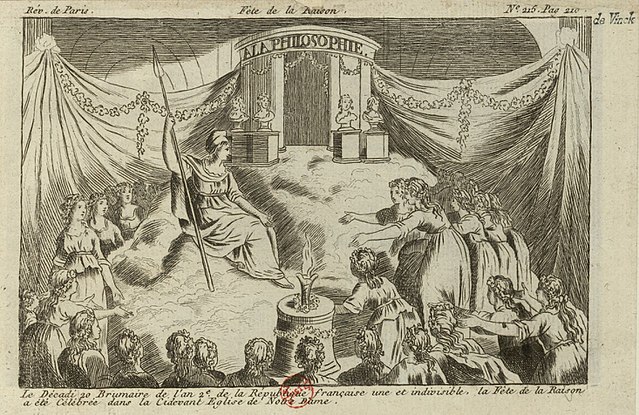Cult of Reason
The Cult of Reason (French: Culte de la Raison) was France's first established state-sponsored atheistic religion, intended as a replacement for Catholicism during the French Revolution. After holding sway for barely a year, in 1794 it was officially replaced by the rival Cult of the Supreme Being, promoted by Robespierre. Both cults were officially banned in 1802 by Napoleon Bonaparte with his Law on Cults of 18 Germinal, Year X.
Origin
Opposition to the Roman Catholic Church was integral among the causes of the French Revolution, and this anti-clericalism solidified into official government policy in 1792 after the First French Republic was declared. Most of the dechristianization of France was motivated by political and economic concerns, and philosophical alternatives to the Church developed more slowly. Among the growing heterodoxy, the so-called Culte de la Raison became defined by some of the most radical revolutionaries like Jacques Hébert, Antoine-François Momoro, Pierre-Gaspard Chaumette, and Joseph Fouché.
Composition
Considerable debate has always persisted about the religiosity of the Cult of Reason. It was a hodgepodge of ideas and activities, a "multifarious phenomenon, marked by disorderliness". The Cult encompassed various elements of anticlericalism, including the subordination of priests to secular authority, wealth confiscation from the Church, and doctrinal heresies both petty and profound. It was atheistic, but celebrated different core principles according to locale and leadership: most famous was Reason, but others were Liberty, Nature, and the victory of the Revolution.
Festival of Reason
The official nationwide Fête de la Raison, supervised by Hébert and Momoro on 20 Brumaire, Year II (10 November 1793) came to epitomize the new republican way of religion. In ceremonies devised and organized by Chaumette, churches across France were transformed into modern Temples of Reason. The largest ceremony of all was at the cathedral of Notre Dame in Paris. The Christian altar was dismantled and an altar to Liberty was installed and the inscription "To Philosophy" was carved in stone over the cathedral's doors. Festive girls in white Roman dresses and tricolor sashes milled around a costumed Goddess of Reason who "impersonated Liberty". A flame burned on the altar which was symbolic of truth. To avoid statuary and idolatry, the Goddess figures were portrayed by living women, and in Paris, the role was played by Momoro's wife, Sophie, who is said to have dressed "provocatively" and, according to Thomas Carlyle, "made one of the best Goddesses of Reason; though her teeth were a little defective."
Before his retirement, Georges Danton had warned against dechristianizers and their "rhetorical excesses", but support for the Cult only increased in the zealous early years of the First Republic. By late 1793, it was conceivable that the Convention might accept the invitation to attend the Paris festival en masse, but the unshakeable opposition of Maximilien Robespierre and others like him prevented it from becoming an official affair. Undeterred, Chaumette and Hébert proudly led a sizable delegation of deputies to Notre Dame.
Public reception
Many contemporary accounts reported the Festival of Reason as a "lurid", "licentious" affair of scandalous "depravities", although some scholars have disputed their veracity. These accounts, real or embellished, galvanized anti-revolutionary forces and even caused many dedicated Jacobins like Robespierre to publicly separate themselves from the radical faction. Robespierre particularly scorned the Cult and denounced the festivals as "ridiculous farces."
In the spring of 1794, the Cult of Reason was faced with official repudiation when Robespierre, nearing complete dictatorial power during the Reign of Terror, announced his own establishment of a new, deistic religion for the Republic, the Cult of the Supreme Being. Robespierre denounced the Hébertistes on various philosophical and political grounds, specifically rejecting their perceived atheism. When Hébert, Momoro, Ronsin, Vincent, and others were sent to the guillotine on 4 Germinal, Year II (24 March 1794), the cult lost its most influential leadership; when Chaumette and other Hébertistes followed them four days later, the Cult of Reason effectively ceased to exist. Both cults were officially banned in 1801 by Napoleon Bonaparte with his Law on Cults of 18 Germinal, Year X.
